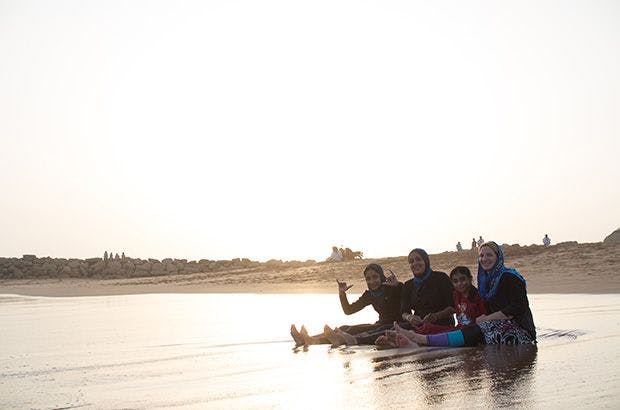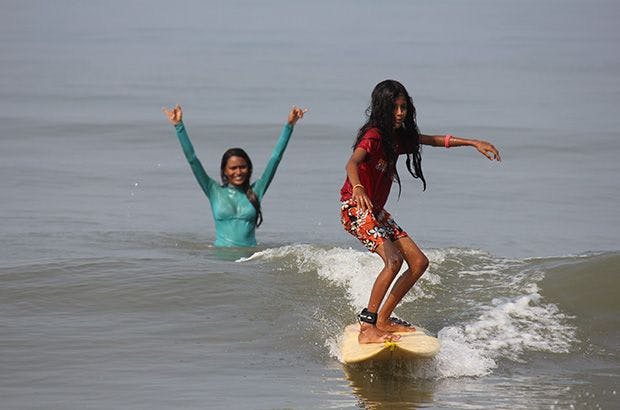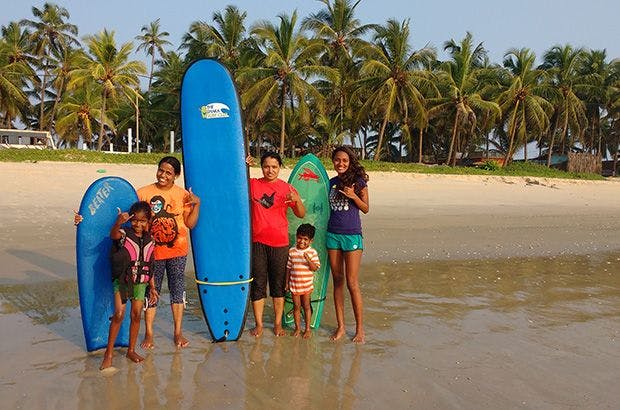Community Projects, Surf cultureSurfing’s Seed Culture: An Alternative Approach

Surfing has been around for long enough now to have history, however there are still a few corners of the world where waves break on wild frontiers and surfing isn’t “a thing”. Maybe a surfer once passed through and rode a few waves to the bemusement of local fishermen (it was probably Peter Troy) however that may have been the end of it, and surfing has simply existed since then as a curious memory. With the rapid growth in both surfing and relatively affordable airline travel over the past few decades however, the trickle of surfers into these previously disregarded locations has planted the seeds of surfing amongst local populations. Surfing, with a clean slate. What could it look like if the visitors importing surfing and the locals picking it up didn’t necessarily point this new outpost down the path mapped out by majority surf culture over the past 70 years or more? What if they took the opportunity to experiment with the accepted model?

“I don’t think there’s ever such a thing as a clean slate in this information age, but seeing surfing take hold somewhere it wasn’t practiced before means there’s the possibility to do it differently. I think a big factor in its acceptance so far, as a sport for both sexes, is that surfing isn’t a formal sport, there were no rules, by its very nature its much more play-like and fluid, creative and self-expressive.”
Dr. Easkey Britton, professional surfer, scientist and social activist
In 2010 Irish surfer Easkey Britton and French filmmaker Marion Poizeau travelled to Iran to explore the remote coastal region of Baluchistan for surfing potential and to test the Western geo-political perception of the country. The short film that they produced led to them returning in 2013 to share surfing in Iran and in doing so make it accessible to everyone, which Marion documented in the feature length “Into The Sea”. This, in turn, led to the foundation of the not-for-profit organization Waves of Freedom which uses surfing as a tool for gender engagement and gender equity across cultures.

“Surfing in Iran was initiated through women, which is a powerful thing given the history of women in surfing and the issues women face in the Middle East in particular. That said, change doesn’t happen over night. What happens in the water doesn’t necessarily translate to change back on land where cultural norms and social rules are strongly upheld and have been so for millennia.
“Who has the freedom to surf?” is a big question and access to coastal spaces and surf breaks are heavily contested around the world.
It’s complex. ‘Women’ are not a homogenous group and ‘we’ don’t exist in a vacuum – it’s not just about what sex you are but how that intersects with multiple factors from gender to race, ethnicity, geography, sexuality, religion, class that shape our ability to make choices and the actions we take.” In Iran, the cultural and social differences are huge -with it that much more difficult for a woman from the local Baloch community, one of the most marginalised in Iran, than it is for a middle-class Persian woman from the capital Tehran to surf.”
Dr. Easkey Britton

On many coasts bordering the Northern Indian Ocean, surfing has yet to properly establish itself. There are obvious exceptions such as the Maldives and Sri Lanka, however for other areas with less consistent or lower quality surf the fact that there are less travelling surfers passing through is compounded by socio-economic factors. In India, the sea is considered dangerous by many people and is a place where men go fishing, but only because they must; it is not a place for pleasure. For Indian women, engaging with surfing is further complicated by the fact that darker skin is considered less desirable because it indicates that one works outside and they are therefore discouraged from spending time in the sun because of social stereotypes. An Indian woman pursuing a passion for surfing is therefore challenging many accepted norms in a society strongly bound by its customs, but that certainly didn’t stop Ishita Malaviya.

Ishita inadvertently became India’s first female surfer when she and her boyfriend Tushar Pathiyan spotted a German exchange student carrying a surfboard and tagged along for a surf lesson taught by visiting American yogis. That moment when curiosity won out over “what was expected” set Ishita and Tushar on a path towards eventually opening their own surf school rather than taking graduate jobs in a city, and the Shaka Surf Club is now gradually helping to change attitudes towards the sea and leisure amongst the local community and is nurturing Indian surf culture. As India’s most well-known surfer, Ishita is not only setting an example to Indians, but to Indian women.
“At our surf school, The Shaka Surf Club, Tushar and I have taught many girls how to surf. Our regular crew includes three young surfer girls from the fishing village we surf in. There are many girls who’ve tried surfing but very few who surf on an everyday basis because most of them live in the big cities, where it is impossible to surf because there are no waves or dirty beaches.
So, right now most of the surfer girls in India either surf on the weekends or once in a few months. It will take some time for the surf culture to really spread in India and for more people to move closer to the sea and adapt to the surfer lifestyle.
With that being said, I think in the near future we will find that it’ll be the women from bigger cities, who come from more open-minded families who will take to surfing and inspire the next generation of women surfers in the country. I have a lot of hope for the future of women’s surfing in India.
I feel like surfing in India is still in its infancy so its hard to tell what direction it will take. However, I know for a fact that surfing can have a really positive impact on the local community. From what I have seen, most of the Indian run surf schools are trying to adopt a “surf + social good” model, which gives people not only the opportunity to come and surf in India but also provides them a platform to engage with the local community and give back by sharing their skills in any area of expertise. There is a strong movement to spread awareness about keeping our beaches and oceans clean. Every pocket of surf community actively organizes regular beach clean-ups weekly or monthly.
It is a really special time to be a surfer in India. We are still a very small surf community where everybody knows everybody and I hope that as more surfers are born that sense of brotherhood will never be lost.”
Ishita Malaviya, Surf School Owner and India’s First Female Surfer

In the Bay of Bengal, on the far side of the Indian Subcontinent to the fledgling surf scene in Iran, young Bangladeshi girls from poor families in the town of Cox’s Bazar are often sent out to sell jewellery or food on the town’s beaches in order to contribute to their family’s income. In a strongly patriarchal society where it is estimated that nearly 5 million children aged between 5-15 are engaged in child labour and where girls living in rural areas are often forced into arranged marriages in their early teens (Bangladesh has the second highest rate of childhood marriage in the world), far too many girls have their childhoods snatched away from them. Cox’s Bazar has a lifesaving and surfing club however, and the head of Bangladesh’s lifeguard service Rashed Alam and his American wife Vanessa Rude began offering both surf and English language lessons to some of the girls who worked on the beach in an effort to give them a few moments of joy in their day and to help boost their confidence by acquiring new skills. In a society so heavily loaded against them, Vanessa and Rashed hope that the girls who they are helping may begin to be given a little more choice and freedom by their families, and thus delay a forced or early marriage. Schemes to share surfing with children who perhaps have little other joy in their lives are not uncommon in developing nations, however the great thing about Vanessa and Rashed’s efforts is that in focusing on the young girls who work on the beach they are also balancing Bangladesh’s surf scene. In many parts of the world surfing is a pastime pursued by those fortunate enough to have either the time or the money to devote to it; Bangladesh’s surf girls have neither, yet thankfully have still had the opportunity.
One location where surfing has deep roots but it has still been possible for an alternative path to be pursued is Papua New Guinea. Here, waves have been ridden prone on wooden boards known as palangs (or “splinters”) for hundreds of years, it is thought developing without any external influence whatsoever. As the modern world of surfing has slowly begun to influence PNG’s surf culture, the development of the local surf scene has been guided by the Founder and President of the Surfing Association of Papua New Guinea, Andy Abel. Andy’s secondary education in Australia and subsequent overseas travels meant that he witnessed how surfing had developed in locations such as Bali, and he became resolved to help his homeland avoid a similar fate. The club structure and Surf Management Plan that he developed means that the traditional local communities who are the custodians of the surf spot are able to plan and manage surf tourism in a sustainable manner. Local surf clubs are a central pillar of implementing SAPNG’s Surf Management Plan, as the club is a democratic body that represents the interests of the local village or clan, and because SAPNG adheres to ISA regulations each surf club must include women in its administration and competitions. Through this cleverly orchestrated management structure, Andy has been able to not only protect Papua New Guinea from the threat of “surf colonisation” but has also tackled the issue of domestic violence against women in PNG by making them decision makers in the surf clubs and giving them equal status in the water. When SAPNG started to receive equipment donations from surf communities in Australia and Japan, Andy went a step further by devising and implementing the “Pink Nose Revolution” which designates half of all surfboards donated for the sole use of female surfers.
“We now receive surfboard donations from Australia and Japan and half of them are painted in line with the new policy that I created, called the Pink Nose Revolution, so that they are destined for use solely by PNG’s female surfers. The aim of this is to empower women with equal rights and opportunities and thus help combat violence against women.”
Andy Abel, ML, President Surfing Association of Papau New Guinea
The thread that runs through these examples is not so much that they all feature female surfers in one role or another, but that they all feature disruptors; people who are challenging the way that surfing develops in a new location, before the influence of wider surf culture can have an impact. In this way surfing might not only become a truly accessible pastime in these places, regardless of gender, wealth or societal status, but, through positive discrimination strategies such as the Pink Nose Revolution, it might also play a role in changing attitudes and saving some individuals from a forced or early marriage or from the suffering domestic abuse and violence. The inference isn’t that there is necessarily anything wrong with wider surf culture, it’s simply a questioning of whether anything can be learnt from it with the benefit of hindsight that might result in an improved alternative, rather than just following blindly along.
“My experiences, through Waves of Freedom, has inspired a shift in my relationship with surfing and how it could be used, as a vehicle or platform, for creating connection and addressing deeper social and ecological issues.”
Dr. Easkey Britton
When approached in this way, the spread of surfing can only be a good thing.